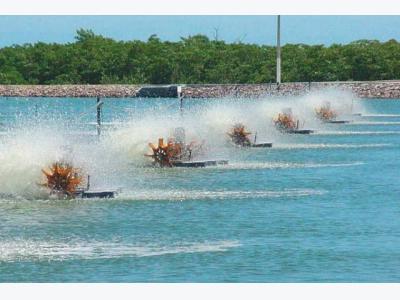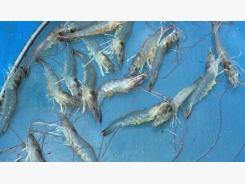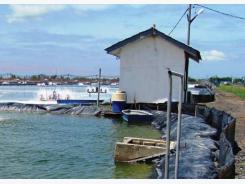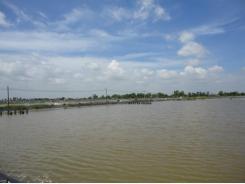Global Shrimp OP: 2001 – Preliminary Report Aerated Pond Management

Farmers Use Aeration to Increase Yields, Stop Oxygen Kills; High Rates Used Only in Intensive Systems
Placement of paddlewheel aerators in a rectangular growout pond in Brazil.
Mechanical aeration is an effective means of improving production efficiency in shrimp farming. Aerators create strong water movement and turbulence, breaking up the air-water interface. This causes oxygenation, mixing, and destratification of the pond water column, which enhances dissolved-oxygen concentrations and lowers the accumulation of nitrogenous compounds.
As the shrimp industry modernizes and culture technologies intensify, supplemental aeration is turning from an occasional to conventional practice at many farms. This article presents preliminary results of the aerated pond management survey conducted with Eastern and Western Hemisphere shrimp farmers as part of the Global Shrimp OP: 2001 program.
Operational Profile
The use of mechanical aeration is rapidly spreading in semi-intensive and intensive shrimp farms. Of 29 respondents to the survey, 59% of the operations were located in the Western Hemisphere. Participant countries included Brazil (8 respondents), India (4), Australia (3), Indonesia, Thailand, Belize, Ecuador, France, Honduras, Japan, Mexico, Nicaragua, South Africa, and the United States.
Surveyed operations were classified as medium to large farms, mostly older than 6 years (61%), with 11-50 ponds (62%). Farms less than five years old with 51-200 ponds were less common, representing 38% and 17% of the respondents, respectively. The primary species cultured was Litopenaeus vannamei (48%), followed by Penaeus monodon (41%), Marsupenaeus japonicus (7%), and Fenneropenaeus indicus (3%).
Pond Characteristics
The bulk of the farms that employed aeration had ponds with the traditional rectangular configuration (66%), and area ranging from 0.5-1 ha (34%) to 1.1-5 ha (38%). Although the benefits of mechanical aeration appear to be better capitalized in smaller culture areas using more sophisticated pond shapes, only a fraction of the farms (3%) used ponds of less than 0.5 ha, and modern configurations such as square (22%) or round (6%) shapes, and raceways (6%). Under these conditions, aerators can effectively create circular currents to assist in the removal of clay materials, detritus, and other undesirable organic particles from water.
Most surveyed farms used ponds with depths of 1.1-1.25 m (24%) to 1.26-1.5 m (34%), but a number of operations ponds exceeded 1.5 m in depth (24%). Aeration is discouraged in very large ponds over 20 ha and shallow ponds (less than 0.75 m), as it can result in inconsistent oxygenation of the rearing area and scouring of the pond bottom. This can produce dead or anaerobic areas in the pond, and disturb toxic materials present in the top layer of the sediment.
Aeration Rates and Costs
Typical average aeration rates ranged 3-5 hp/ha (Figure 1). While higher aeration rates are in use, they seem to be limited to very intensive or heterotrophic-based rearing systems. Most farmers estimate their horsepower rating on motor size (72%), while very few use the actual draw power of motor (28%).

Figure 1. Aeration rates for surveyed farms.

Figure 2. Cost of power for surveyed farms
Respondents indicated electricity as their primary source of power for aeration, originated either from onsite power generation (48%) or utility (48%). Only one respondent used direct drive from gas or diesel motor. Almost half the farms evaluated used a backup power supply for emergencies, followed by 29% with no backup and 25% with partial backup. This agrees with the finding that 30% of the respondents indicated power outage as one of leading causes of lowoxygen shrimp mortality in their growout ponds.
Operational Cost Restrictions
One of the greatest restrictions to a more widespread use of aeration seems to be related to its operational costs, particularly power expenses. Interestingly, aeration is becoming quite popular in countries like Brazil, where electricity derived from hydroelectric plants is common in rural areas and relatively inexpensive compared to other power sources. In Brazil, it is estimated that one kWh generated by diesel fuel is at least three times more expensive than electricity from utility sources.
Sixty percent of the respondents indicated their power costs did not exceed U.S. $0.07/kWh (Figure 2). Costs of diesel fuel ranged from U.S. $0.310.40/l (8% of the respondents) to $0.41-0.50/l. Alternative energy sources for aeration, such as solar or eolic energy, will be a likely area of investigation in the future.
Equipment Purchases
Under specific situations (e.g., intensification, treatment of effluents), the economic and environmental benefits of aeration clearly exceed its costs. When purchasing aeration equipment, respondents indicated aerator efficiency, reliability, and ease of maintenance were the most important areas to consider (Table 1).
Table 1. Factors considered during purchasing of aeration equipment. Values indicate number of respondents.
| Factors | First Priority | Second Priority | Third Priority | Fourth Priority | Fifth Priority |
| Aerator cost | 3 | 7 | 7 | 10 | 2 |
| Aerator reliability | 8 | 10 | 4 | 5 | 0 |
| Aerator efficiency | 16 | 8 | 4 | 1 | 0 |
| Ease of maintenance | 2 | 4 | 13 | 9 | 1 |
| Credit availability | 0 | 0 | 1 | 2 | 20 |
Aerator Positioning
The arrangement of aerator equipment in a pond is an important factor to be considered. It affects water-circulation patterns, and determines oxygenated zones and areas of sediment deposition in a pond. Shrimp tend to avoid pond areas with low dissolvedoxygen levels or a build-up of ammonia or hydrogen sulfide.
In this survey, aerator positioning often related to the configuration and area of the pond. In round and square ponds, farmers placed aerators near corners (17% of the respondents), between outside edge and center of the pond (26%) to create currents with a circular pattern. This allowed a reduction in the sludge area as sediment accumulates in the center, where a drainage system is usually located.
In rectangular ponds, aerators were often installed near each other 45-90º from pond walls around the outside perimeter (29%). For 21% of the respondents, the aerators were all pointed in the same direction towards prevalent winds. In exceptional cases, some farmers place aerators in water distribution channels to increase dissolvedoxygen (D.O.) levels prior to supplying new water to ponds (Figure 3).
Figure 3. Aerators operating in distribution channel to increase dissolved-oxygen levels of reuse water.
Objectives of Aeration
Farmers used aeration for a number of reasons, but primarily to increase yields (41%). One-quarter of all the operations indicated they attained shrimp yields of 3,001-5,000 kg/ha/cycle. Higher yields of 5,000 kg/ha/cycle to more than 15,000 kg/ha/ cycle, were not uncommon among respondents, representing 22% of all the participating farms. Only 11% of the operations indicated they obtained 500-1,000 kg/ha/cycle yields.
Most growout stocking densities were in the 21-30 shrimp/m2 (32%) and 31-50 shrimp/m2 (32%) range. More intensive stocking conditions, 51-100 shrimp/m2 and over 100 shrimp/ m2, were limited to 7% and 11% of the respondents, respectively
At 28% of respondents, prevention of oxygen kills in semi-intensive ponds came as the second primary reason for aeration use. Depletion of oxygen is common in more-intensive culture systems or under conditions of extreme temperatures, where there may be an unusual increase in photosynthetic activity. This causes a rapid increment in D.O. concentrations during daylight, followed by a reduction or complete depletion in the night. In fact, excessive phytoplankton bloom was considered one of the biggest causes for low-oxygen mortality in aerated ponds by 30% of the respondents.


Electrical switch boxes at pond side control individual aerators and prevent equipment damage from electrical power fluctuations.
In areas with an incidence of disease outbreaks, water exchange must be avoided, and D.O. concentrations can only be sustained with supplemental aeration. Intensive aeration is more commonly used to continually resuspend organic material and create heterotrophic microbial communities to purify water and recycle protein (19%). Other purposes for aeration in cluded water circulation (6%), destratification of zero-exchange ponds (3%), and reduction in sludge area (3% of responses).
Research
Aeration can be used in a number of culture systems and situations, either as a remedial measureor practical method to enhance production output. Still, there are several areas critical for research.
Surveyed farmers indicated their highest priorities for research were improved gas exchange efficiency, and study of the importance of aeration versus water circulation. Research on automatic aerator control by D.O. sensors, and variable operating speed (day versus night) followed as priorities. Other areas included aerator arrangement and performance tests.
As shrimp farmers become more knowledgeable about the benefits of pond aeration, management strategies and less-expensive technologies should evolve, making aeration a more accessible and widespread tool in shrimp aquaculture.
Aeration can be used in a number of culture systems and situations, either as a remedial measure or practical method to enhance production output.
Authors:
Alberto J.P. Nunes, Ph.D.
Agribrands Purina do Brasil
São Paulo, Brazil
albertojpn@agribrands.com.br
Yont Musig, Ph.D.
Kasetsart University
Bangkok, Thailand
ffisyon@ku.ac.th
Related news
Tools

Phối trộn thức ăn chăn nuôi

Pha dung dịch thủy canh

Định mức cho tôm ăn

Phối trộn phân bón NPK

Xác định tỷ lệ tôm sống

Chuyển đổi đơn vị phân bón

Xác định công suất sục khí

Chuyển đổi đơn vị tôm

Tính diện tích nhà kính

Tính thể tích ao




 Culture of Penaeus vannamei in Single-Phase & Three-Phase…
Culture of Penaeus vannamei in Single-Phase & Three-Phase…  Bacillus Probiotics Improve Hatchery, Nursery Production In EMS-Hit…
Bacillus Probiotics Improve Hatchery, Nursery Production In EMS-Hit…